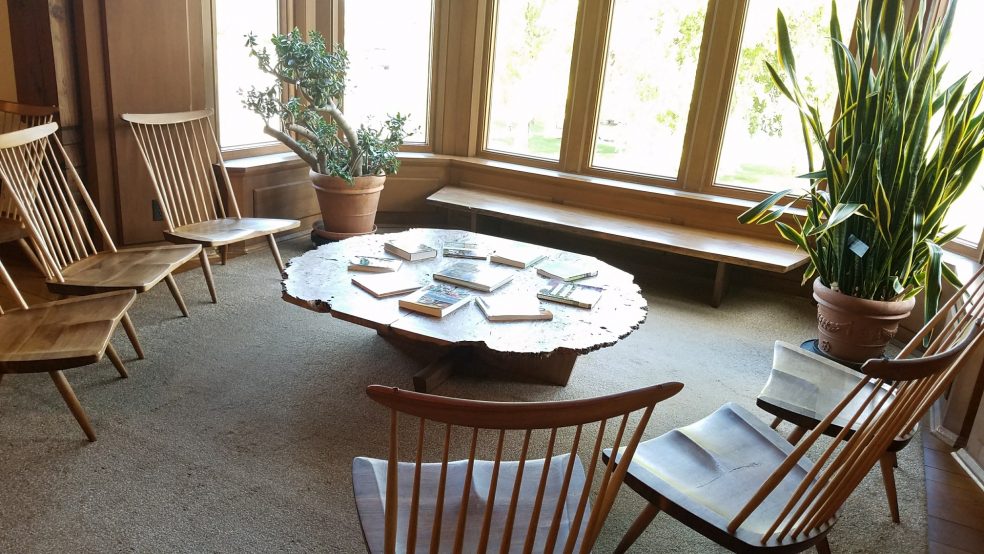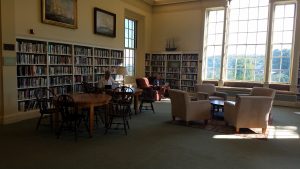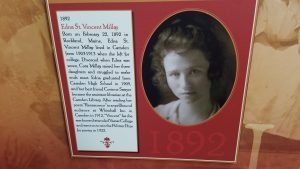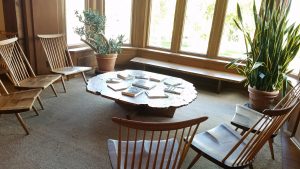
Andersen Horticultural Library
The Value of Thought
I just returned from a trip to Maine. While there, we happened upon this charming quaint town, Ogunquit. We visited a small museum there that was built by Henry Strater, a friend of Ernest Hemingway. They were of one of the same spirit; they loved the bottle, fishing, art, and of course, women – at least that’s what the dossier told us. In any case, this small museum had beautiful gardens with sculptures by the sea, and a wonderful works of art inside. There was a temporary exhibit “Alison Rector: The Value of Thought”. Alison’s oil paintings in this collection are of the interiors of Carnegie libraries in Maine. http://greenhutgalleries.me/gallery/alison-rector/
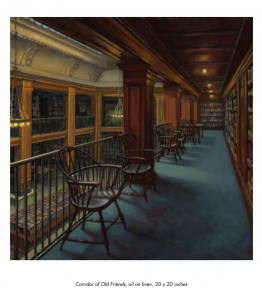
Artist; Alison Rector
According to Wikipedia, Andrew Carnegie endowed grants to build 1689 libraries in the United States between 1883 and 1929. https://en.wikipedia.org/wiki/Carnegie_library. That is in addition to libraries built outside the United States. While researching this, I discovered that there were 65 Carnegie libraries built in Minnesota (fyi, there are some that are still operating as libraries, but many have been converted to office buildings, art centers, & some have been razed). https://en.wikipedia.org/wiki/List_of_Carnegie_libraries_in_Minnesota
Additionally, while in Maine, we stopped at another small town, Camden, the home of the poet Edna St. Vincent Millay. We were walking along a harbor walkway and I spotted what looked like a beautiful park up on top of a hill. I thought I’d walk up to see if I could get a better pic of the harbor and noticed that it was a library. After seeing Alison Rector’s exhibit, I couldn’t resist walking into the library. While it wasn’t a Carnegie library, as depicted her exhibit, it should’ve been. It was stunning! It made me think of our beautiful little library at the Arboretum, so I did a little research.
As many of you know, the library is named the Andersen Horticultural Library after the late Elmer Andersen & Eleanor Andersen. http://www.legacy.com/obituaries/twincities/obituary.aspx?pid=2832938
At one event, Elmer stated “All of us have addictions or hang ups of one kind or another. One of mine has been a love of reading and book collecting.” And so, Elmer & Eleanor’s love of books was the beginning of this beautiful gem.
The library architect is Edwin Lundie from MN and construction was completed in Fall, 1973. The draperies are handwoven from Indian cotton with a crewelwork in autumn colors. The furniture was commissioned by the Andersens, and was designed and built by George Nakashima. http://www.nakashimawoodworker.com/philosophy/
As all of us who have visited the library know the Nakashima furniture is a highlight of the library. Most of the Library’s furniture was built from American black walnut. The tables are book matched, coming from the same tree. The coffee table is from the burl of an English oak that grew for at least 400 years. And while the chairs near the coffee table look way too low, have a seat with a book and you’ll discover that they are extremely comfortable. George was born in 1905 in Spokane, WA and attended MIT. He traveled for awhile and started his first woodwork shop in Seattle, but was sent to an internment camp in 1941. At the internment camp, he met a Japanese woodworker that taught him to learn the “nature of wood”. Nakashima felt the furniture should be used and didn’t mind some “distress”. In 1943, Nakashima was released from the internment camp under the sponsorship of an American architect he worked under before the War. He moved to Antonin Raymond’s farm in New Hope, PA and continued his craft in New Hope until his death in1990. His daughter, Mira, has continued her father’s work.
Elmer believed that the Horticultural library bearing his name should have some specialty. The early motto of the library was “Happiness is bringing people and plants together”, so the library started a Rolodex of plants and where to obtain them. In addition, they began catalog all the seed catalogs, as they felt the old catalogs were scattered all across the country and provided valueable research material. In addition, they began a collection of plate books. Plate books were taken from farm to farm by salesmen in the horse & buggy days. Orders were placed off the plate books and the salesman would return with the nursery stock when it was time to plant. Now that is service.
The library also houses historic special collection that is housed in a climate control area, which was added by the Andersens in 1988. This historic collection has early herbals dating back to the 1530’s. Herbals were as valuable as the Family Bible back in historic times. Some of these herbals were donated by the Andersens, others are donated in memory of individuals, and others are purchased at various auctions such as Christies. The Andersen Horticultural Library has one of Americas largest collection of seed & nursery catalogs with 6700 firms represented and over 72,000 pieces dating from 1614. There is also a collection of nearly 20,000 books & 300 subscriptions to periodicals, including many on herbs. So, head on down to the library, enjoy the beautiful surroundings, and peruse a few books or herb mags.
“All I could see from where I stood
Was three long mountains and a wood;
I turned and looked another way,
And saw three islands in a bay”
Edna St. Vincent Millay
Painted on an interior dome in the Camden Public Library, Maine
Sources; Andersen Horticultural Library; The First 25 Years by June Rogier & Richard Isaacson, http://www.lib.umn.edu/ahl.com , http://www.nakashimawoodworker.com, Wikipedia.com

